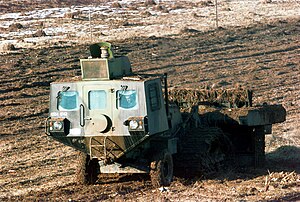| This article needs additional citations for verification. Please help improve this article by adding citations to reliable sources. Unsourced material may be challenged and removed. Find sources: "Aardvark JSFU" – news · newspapers · books · scholar · JSTOR (November 2024) (Learn how and when to remove this message) |
| Aardvark area mine clearing system (AMCS) | |
|---|---|
 A French Army 17th Engineering Regiment Aardvark AMCS in Bosnia-Herzegovina A French Army 17th Engineering Regiment Aardvark AMCS in Bosnia-Herzegovina | |
| Type | demining vehicle |
| Place of origin | United Kingdom |
| Specifications | |
| Crew | 1+1 |
| Armour | 56 mm armoured glass windows, double-skin cab floor |
| Engine | turbo charged New Holland diesel engine 160 hp |
| Transmission | 4-speed synchromesh; 4 gears, 16-speed |
The Aardvark AMCS Mk4 is a British-made mine flail vehicle built by Aardvark Clear Mine Ltd of Dumfries, Scotland.
The AMCS flail system was developed in Aberdeenshire by David Macwatt of Elgin, Scotland and George Sellar & Son of Huntly (system designers were James (Barney) Hepburn, Pat McRobbie and Alistair Birnie) with the cooperation of Ford Motor Co, Basildon. George Sellar & Son owned a number of patents concerning the rotor and chain design and electronic depth contouring system and manufactured the flail assembly. The armoured vehicle was manufactured by Glover & Webb of Southampton until their acquisition by GKN who continued to armour vehicles for a period before Penman Engineering were given the contract.
Aardvark Clear Mine Ltd was acquired in 2016 from Penman Engineering Ltd of Dumfries, and is now owned by its shareholders.
Aardvark's global business is managed from the UK with operational and training facilities in Dumfries in the Scottish Borders and Insch in Aberdeenshire. The company also has offices in Washington, D.C. and in Riyadh in Saudi Arabia.
Aardvark clearance machines have been used by the military, the UN, NGOs, and other charitable organisations for humanitarian mine clearance operations in Europe, Africa and in the Middle and Far East. Aardvarks have also been chosen by the British and American forces for landmine clearance in Afghanistan and Iraq.
Design
The vehicle consists of an armoured cab with a front-mounted flail system. The system has 72 chains with 66 striker tips.
- Armour: 56 mm armoured glass windows, double-skin cab floor
- Crew: two - one operator, one crew member
- Powertrain: 160 hp six-cylinder turbo charged New Holland diesel engine
- Transmission: four-speed synchromesh; four gears, 16-speed
- Flail system: 72 chains, 66 tips
Users

Users of the AardvarkJSFU system:
 Azerbaijan - (Azerbaijan Army)
Azerbaijan - (Azerbaijan Army) Pakistan - (Pakistan Army)
Pakistan - (Pakistan Army) Canada - (Canadian Army) - deployed in Afghanistan
Canada - (Canadian Army) - deployed in Afghanistan France - (French Army)
France - (French Army) Botswana - (Botswana Ground Force)
Botswana - (Botswana Ground Force) Indonesia - (Indonesian Army)
Indonesia - (Indonesian Army) Ireland - (Irish Army)
Ireland - (Irish Army) Jordan - (Royal Jordanian Land Force)
Jordan - (Royal Jordanian Land Force) Latvia - (Latvian Special Forces)
Latvia - (Latvian Special Forces) Netherlands - (Royal Netherlands Army)
Netherlands - (Royal Netherlands Army) Saudi Arabia - (Royal Saudi Land Force)
Saudi Arabia - (Royal Saudi Land Force) Singapore - (Singapore Army)
Singapore - (Singapore Army) South Korea - (Republic of Korea Army)
South Korea - (Republic of Korea Army) Syrian opposition
Syrian opposition United States - (United States Army)
United States - (United States Army) United Kingdom - (British Army)
United Kingdom - (British Army)
See also
References
- "Aardvark digs in to rid the world of landmines". The Independent. 3 November 1997. Archived from the original on 5 March 2016. Retrieved 18 September 2012.
- "THE KILLING FIELD Front-line troops get the grim word on Iraqi mines". Boston Globe. 12 February 1991. Archived from the original on 31 January 2013. Retrieved 18 September 2012.
- ^ Trevithick, Joseph (26 February 2019). "Moscow Has A "Syrian Fracture" Propaganda Train Loaded With War Trophies Crisscrossing Russia". thedrive.com.
- International Institute for Strategic Studies (2021). The Military Balance. p. 451. ISBN 9781032012278.
External links
Categories: